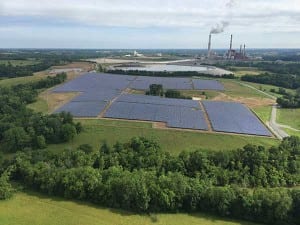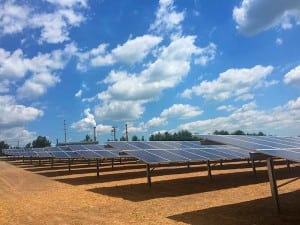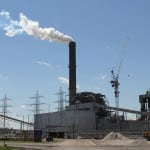U.S. utilities continue to announce closures of financially troubled and older coal-fired power plants even as government officials work on a bailout plan to keep them operating.
Owners of a coal plant in Montana that has only been online since 2006 informed the state’s Public Service Commission (PSC) last week of plans to shutter the facility early next year if they can’t find a buyer. The news comes at the same time Louisville Gas & Electric and Kentucky Utilities (LG&E-KU) said it would close two long-running coal-fired units at the E.W. Brown Generating Station near Harrodsburg, Kentucky, in February 2019.
The announcements are the latest in a series of closures announced in recent months, including three large coal-fired plants in Texas—two operated by Vistra Energy and another by Luminant, a Vistra subsidiary—that generate about 4.2 GW of electricity, or about 12% of the state’s coal-fired generation capacity. Another large Texas plant, CPS Energy’s 840-MW Deely station in San Antonio, is scheduled to close in 2018.
A Missouri utility in late October filed an application with that state’s PSC to build a $1.5 billion wind power project and accelerate the closure of a coal-fired power plant that was already scheduled to be decommissioned in 2019—15 years ahead of its original retirement date. Empire District Electric Co. said costs to continue to operate the 213-MW Asbury Generating Station in Asbury, Missouri, would be about one-third higher than the cost for wind generation. In an email to POWER, David Swain, the utility’s president, said “We are pleased to put forward this initiative, which demonstrates an innovative approach to reduce energy costs for our customers.”
Federal Energy Regulatory Commission (FERC) Acting Chairman Neil Chatterjee, meanwhile, last week said he will implement an interim plan to provide relief for financially struggling coal and nuclear plants even as his agency considers a broader change to pricing in electricity markets proposed by the Department of Energy (DOE). Chatterjee said his plan, a directive to regional transmission organizations (RTOs) to update market tariffs to keep baseload plants operating, would allow more time for FERC to institute rules on grid resilience and market compensation designed to prop up coal and nuclear generation.

But announcements of closures of coal-fired plants continue even as FERC considers changing the pricing structure of power markets. In Kentucky, Paul W. Thompson, president and COO of LG&E-KU, a subsidiary of Pennsylvania-based PPL Corp., said Units 1 (106-MW capacity, online in 1957) and 2 (166 MW, online in 1963) at Brown will be closed. The units are not equipped with the latest air pollution controls. The 409-MW Unit 3, which came online in 1971 and has upgraded pollution controls, will continue to operate. With the closures, LG&E-KU will have shuttered eight coal-fired units in the past five years, including three at the Cane Run plant in Louisville. Those units were replaced by a new natural gas-fired unit at Cane Run, named a POWER Top Plant in 2016.
“Retiring two of our oldest and most expensive coal-fired generating units, while also avoiding more-costly environmental capital expenditures for [regulatory] compliance, benefits our customers,” Thompson said. He added that a 10-MW solar farm and 33-MW hydroelectric plant at Brown will remain online as his group transitions to more use of renewable generation sources in addition to natural gas. The plant also has seven natural gas-fired turbines with a combined generation capacity of 906 MW. LG&E-KU has decreased the amount of coal-fired generation in its fleet from 98% in 2011 to about 80% today.

Interestingly, LG&E-KU cited energy efficiency practices, including the use of LED lighting at its plants, as playing a role in its decision to close the Brown units. The company said upgraded lighting at its facilities has saved enough electricity so that the company does not need to build a new generating unit despite the closures.
The DOE says the increased use of LED lighting has the potential to cut electricity demand by the generation equivalent of 44 large power plants by 2027.
In Montana, Gary Arneson, vice president of operations for Heorot Power, in a November 15 letter to the Montana PSC said that if the company can’t find a buyer for the Hardin Generating Station, the plant could close by the middle of 2018. The plant was built in 2006; Heorot has used short-term energy contracts to sell the plant’s electricity. Heorot Power owns Colorado Energy, which operates the plant. Rocky Mountain Power, a division of PacifiCorp, owns the plant.
The Hardin plant has been troubled for months. The plant’s owners owe more than $2 million in back taxes and penalties to Big Horn County; $12 million in bonds were issued to build infrastructure to support the plant’s operations, and those bonds are in default due to the non-payment of taxes.
A POWER magazine analysis of announced closures of coal-fired units estimates nearly 14 GW of generation capacity will be mothballed in 2018, almost double the 7.6 GW expected to go offline this year. About 13 GW of coal capacity was closed in 2016, and about 18 GW was shuttered in 2015, to date the largest single-year retirement of coal-fired units.
—Darrell Proctor is a POWER associate editor (@DarrellProctor1, @POWERmagazine).










